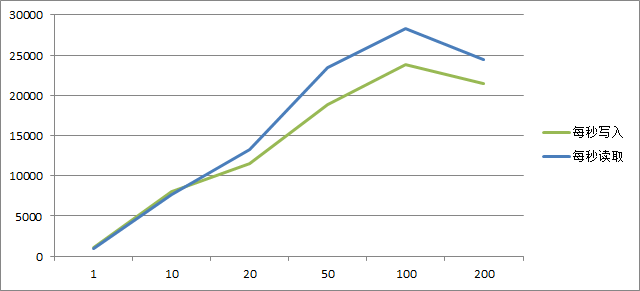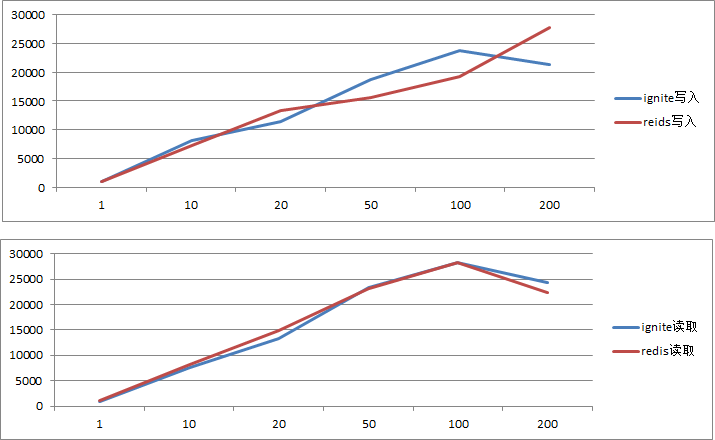性能测试以及对redis
Ignite性能测试以及对redis的对比
测试方法
为了对Ignite做一个基本了解,做了一个性能测试,测试方法也比较简单主要是针对client模式,因为这种方法和使用redis的方式特别像。测试方法很简单主要是下面几点:
- 不作参数优化,默认配置进行测试
- 在一台linux服务器上部署Ignite服务端,然后自己的笔记本作客户端
- 按1,10,20,50,100,200线程进行测试
测试环境说明
服务器:
[09:36:56] ver. 1.7.0#20160801-sha1:383273e3
[09:36:56] OS: Linux 2.6.32-279.el6.x86_64 amd64
[09:36:56] VM information: Java(TM) SE Runtime Environment 1.7.0_07-b10 Oracle Corporation Java HotSpot(TM) 64-Bit Server VM 23.3-b01
[09:36:56] Configured plugins:
[09:36:56] ^-- None
[09:36:56]
[09:36:56] Security status [authentication=off, tls/ssl=off]CPU:4核
内存8GB
网卡100M
虚拟机
客户机:
[13:05:32] ver. 1.7.0#20160801-sha1:383273e3
[13:05:32] OS: Windows 7 6.1 amd64
[13:05:32] VM information: Java(TM) SE Runtime Environment 1.8.0_40-b26 Oracle Corporation Java HotSpot(TM) 64-Bit Server VM 25.40-b25
[13:05:32] Initial heap size is 128MB (should be no less than 512MB, use -Xms512m -Xmx512m).
[13:05:34] Configured plugins:
[13:05:34] ^-- None
[13:05:34]
[13:05:35] Security status [authentication=off, tls/ssl=off]
[13:05:51] Performance suggestions for grid (fix if possible)
[13:05:51] To disable, set -DIGNITE_PERFORMANCE_SUGGESTIONS_DISABLED=true
[13:05:51] ^-- Decrease number of backups (set 'backups' to 0)CPU:4核,i5-4210u
内存8GB
笔记本win7 64位
网卡:100M
测试代码
package org.j2server.j2cache.cache.iginte;
import java.util.Arrays;
import org.apache.ignite.Ignite;
import org.apache.ignite.IgniteCache;
import org.apache.ignite.Ignition;
import org.apache.ignite.cache.CacheMode;
import org.apache.ignite.configuration.CacheConfiguration;
import org.apache.ignite.configuration.IgniteConfiguration;
import org.apache.ignite.spi.discovery.tcp.TcpDiscoverySpi;
import org.apache.ignite.spi.discovery.tcp.ipfinder.vm.TcpDiscoveryVmIpFinder;
public class IgniteTest {
//测试的数据行数
private static final Integer test_rows = 50000;
private static final Integer thread_cnt = 10;
private static final String cacheName = "Ignite Cache";
private static Ignite ignite;
private static boolean client_mode = false;
static {
getIgnite();
}
public static void main(String[] args) {
MultiThread();
}
private static Ignite getIgnite() {
if (ignite == null) {
TcpDiscoverySpi spi = new TcpDiscoverySpi();
TcpDiscoveryVmIpFinder ipFinder = new TcpDiscoveryVmIpFinder();
ipFinder.setAddresses(Arrays.asList("192.168.49.204"));
spi.setIpFinder(ipFinder);
CacheConfiguration cacheConfiguration = new CacheConfiguration<String, DataClass>();
cacheConfiguration.setCacheMode(CacheMode.PARTITIONED);
cacheConfiguration.setBackups(1);
IgniteConfiguration cfg = new IgniteConfiguration();
cfg.setClientMode(client_mode);
cfg.setDiscoverySpi(spi);
cfg.setCacheConfiguration(cacheConfiguration);
ignite = Ignition.start(cfg);
}
System.out.println("是否客户端模式:" + client_mode);
return ignite;
}
private static void MultiThread() {
System.out.println("==================================================================");
System.out.println("开始测试多线程写入[线程数:"+thread_cnt+"]");
Long startTime = System.currentTimeMillis();
Thread[] threads = new Thread[thread_cnt];
Ignite ignite = getIgnite();
IgniteCache<String, DataClass> cache = ignite.getOrCreateCache(cacheName);
for (int i = 0; i < threads.length; i++) {
threads[i] = new Thread(new TestThread(true, cache));
}
for (int i = 0; i< threads.length; i++) {
threads[i].start();
}
for(Thread thread : threads){
try {
thread.join();
} catch (InterruptedException e) {
e.printStackTrace();
}
}
Long endTime=System.currentTimeMillis(); //获取结束时间
float interval = endTime-startTime == 0 ? 1 : endTime-startTime;
float tpms = (float)test_rows/interval;
System.out.println("程序运行时间: "+ interval+"ms");
System.out.println("每毫秒写入:"+tpms+"条。");
System.out.println("每秒写入:"+tpms*1000+"条。");
System.out.println("==================================================================");
System.out.println("开始测试多线程读取[线程数:"+thread_cnt+"]");
startTime = System.currentTimeMillis();
Thread[] readthreads = new Thread[thread_cnt];
for (int i = 0; i < readthreads.length; i++) {
readthreads[i] = new Thread(new TestThread(false, cache));
}
for (int i = 0; i< readthreads.length; i++) {
readthreads[i].start();
}
for(Thread thread : readthreads){
try {
thread.join();
} catch (InterruptedException e) {
e.printStackTrace();
}
}
endTime=System.currentTimeMillis(); //获取结束时间
interval = endTime-startTime == 0 ? 1 : endTime-startTime;
tpms = (float)test_rows/interval;
System.out.println("程序运行时间: "+ interval+"ms");
System.out.println("每毫秒读取:"+tpms+"条。");
System.out.println("每秒读取:"+tpms*1000+"条。");
}
static class TestThread implements Runnable {
private boolean readMode = true;
private IgniteCache<String, DataClass> cache;
public TestThread(boolean readMode, IgniteCache<String, DataClass> cache){
this.readMode = readMode;
this.cache = cache;
}
@Override
public void run() {
for (int i = 0; i < test_rows/thread_cnt; i++) {
if (this.readMode) {
cache.get(Integer.toString(i));
} else {
DataClass dc = new DataClass();
dc.setName(Integer.toString(i));
dc.setValue(i);
dc.setStrValue("asdfadsfasfda");
cache.put(Integer.toString(i), dc);
}
}
}
}
}
import java.io.Serializable;
public class DataClass implements Serializable{
private String name;
private long value;
private String strValue;
public String getName() {
return name;
}
public void setName(String name) {
this.name = name;
}
public long getValue() {
return value;
}
public void setValue(long value) {
this.value = value;
}
public String getStrValue() {
return strValue;
}
public void setStrValue(String strValue) {
this.strValue = strValue;
}
}测试数据
最终测试的结果还是有点意思,随着线程的增长读写性能大幅提升,但是到了200的时候就开始下降。下面是测试数据:
[12:53:40] Topology snapshot [ver=20, servers=1, clients=1, CPUs=8, heap=2.8GB]
==================================================================
开始测试多线程写入[线程数:1]
程序运行时间: 49066.0ms
每毫秒写入:1.0190356条。
每秒写入:1019.0356条。
==================================================================
开始测试多线程读取[线程数:1]
程序运行时间: 51739.0ms
每毫秒读取:0.966389条。
每秒读取:966.389条。
[12:56:22] Topology snapshot [ver=22, servers=1, clients=1, CPUs=8, heap=2.8GB]
==================================================================
开始测试多线程写入[线程数:10]
程序运行时间: 6215.0ms
每毫秒写入:8.045053条。
每秒写入:8045.0527条。
==================================================================
开始测试多线程读取[线程数:10]
程序运行时间: 6526.0ms
每毫秒读取:7.661661条。
每秒读取:7661.661条。
[12:57:04] Topology snapshot [ver=24, servers=1, clients=1, CPUs=8, heap=2.8GB]
==================================================================
开始测试多线程写入[线程数:20]
程序运行时间: 4353.0ms
每毫秒写入:11.486331条。
每秒写入:11486.331条。
==================================================================
开始测试多线程读取[线程数:20]
程序运行时间: 3768.0ms
每毫秒读取:13.269639条。
每秒读取:13269.639条。
[12:57:34] Topology snapshot [ver=26, servers=1, clients=1, CPUs=8, heap=2.8GB]
==================================================================
开始测试多线程写入[线程数:50]
程序运行时间: 2657.0ms
每毫秒写入:18.818216条。
每秒写入:18818.217条。
==================================================================
开始测试多线程读取[线程数:50]
程序运行时间: 2138.0ms
每毫秒读取:23.386343条。
每秒读取:23386.344条。
[12:58:00] Topology snapshot [ver=28, servers=1, clients=1, CPUs=8, heap=2.8GB]
==================================================================
开始测试多线程写入[线程数:100]
程序运行时间: 2095.0ms
每毫秒写入:23.866348条。
每秒写入:23866.348条。
==================================================================
开始测试多线程读取[线程数:100]
程序运行时间: 1764.0ms
每毫秒读取:28.344671条。
每秒读取:28344.672条。
[12:59:19] Topology snapshot [ver=30, servers=1, clients=1, CPUs=8, heap=2.8GB]
==================================================================
开始测试多线程写入[线程数:200]
程序运行时间: 2333.0ms
每毫秒写入:21.431633条。
每秒写入:21431.633条。
==================================================================
开始测试多线程读取[线程数:200]
程序运行时间: 2049.0ms
每毫秒读取:24.402147条。
每秒读取:24402.146条。用图形看看比较直观
不使用客户端模式
只不过我发现如果不使用client_mode,也就是都是server模式时写入性能还是很强的,但是读取有点搓。
[14:15:02] Topology snapshot [ver=22, servers=2, clients=0, CPUs=8, heap=2.8GB]
是否客户端模式:false
==================================================================
开始测试多线程写入[线程数:1]
是否客户端模式:false
程序运行时间: 828.0ms
每毫秒写入:60.386475条。
每秒写入:60386.477条。
==================================================================
开始测试多线程读取[线程数:1]
程序运行时间: 28819.0ms
每毫秒读取:1.7349665条。
每秒读取:1734.9666条。
[14:08:55] Topology snapshot [ver=10, servers=2, clients=0, CPUs=8, heap=2.8GB]
是否客户端模式:false
==================================================================
开始测试多线程写入[线程数:10]
是否客户端模式:false
程序运行时间: 813.0ms
每毫秒写入:61.500614条。
每秒写入:61500.613条。
==================================================================
开始测试多线程读取[线程数:10]
程序运行时间: 5965.0ms
每毫秒读取:8.38223条。
每秒读取:8382.2295条。
[14:09:48] Topology snapshot [ver=12, servers=2, clients=0, CPUs=8, heap=2.8GB]
是否客户端模式:false
==================================================================
开始测试多线程写入[线程数:20]
是否客户端模式:false
程序运行时间: 812.0ms
每毫秒写入:61.576355条。
每秒写入:61576.355条。
==================================================================
开始测试多线程读取[线程数:20]
程序运行时间: 5157.0ms
每毫秒读取:9.6955595条。
每秒读取:9695.56条。
[14:10:25] Topology snapshot [ver=14, servers=2, clients=0, CPUs=8, heap=2.8GB]
是否客户端模式:false
==================================================================
开始测试多线程写入[线程数:50]
是否客户端模式:false
程序运行时间: 686.0ms
每毫秒写入:72.8863条。
每秒写入:72886.3条。
==================================================================
开始测试多线程读取[线程数:50]
程序运行时间: 4321.0ms
每毫秒读取:11.571396条。
每秒读取:11571.3955条。
[14:11:01] Topology snapshot [ver=16, servers=2, clients=0, CPUs=8, heap=2.8GB]
是否客户端模式:false
==================================================================
开始测试多线程写入[线程数:100]
是否客户端模式:false
程序运行时间: 830.0ms
每毫秒写入:60.240963条。
每秒写入:60240.965条。
==================================================================
开始测试多线程读取[线程数:100]
程序运行时间: 3963.0ms
每毫秒读取:12.616705条。
每秒读取:12616.705条。
[14:13:58] Topology snapshot [ver=20, servers=2, clients=0, CPUs=8, heap=2.8GB]
是否客户端模式:false
==================================================================
开始测试多线程写入[线程数:200]
是否客户端模式:false
程序运行时间: 1014.0ms
每毫秒写入:49.309666条。
每秒写入:49309.664条。
==================================================================
开始测试多线程读取[线程数:200]
程序运行时间: 3179.0ms
每毫秒读取:15.728216条。
每秒读取:15728.216条。用图形看看比较直观
从这个数据可以看出来,在这种都是服务端的模式下,写入性能基本稳定,在达到200线程时出现衰减;而读取则基本是线性的,到100线程差不多也就到顶了。
与redis的对比
原本是想和redis作一个对比测试的,先是做了redis的测试。redis客户端用的jedis2.8.1,同时服务端用的是redis3.2.2,其他的环境和上面的一样。
结果测试数据发现redis和ignite使用客户端模式时竟然很相近。所以我怀疑是因为我对redis不了解redis没作优化导致的?但是Ignite我也是直接启动的,一点优化也没作,还是说测试的代码写法不对呢?
下面是redis的测试代码
import redis.clients.jedis.Jedis;
public class redis {
private static final String ip = "192.168.49.200";
private static final String auth = "your pwd";
private static final Integer port = 6379;
//测试的数据行数
private static final Integer test_rows = 50000;
//线程数
private static final Integer thread_cnt = 200;
public static void main(String[] args) {
MultiThread();
}
private static void MultiThread() {
System.out.println("==================================================================");
System.out.println("开始测试多线程写入[线程数:"+thread_cnt+"]");
Long startTime = System.currentTimeMillis();
Thread[] threads = new Thread[thread_cnt];
for (int i = 0; i < threads.length; i++) {
threads[i] = new Thread(new TestThread(true));
}
for (int i = 0; i< threads.length; i++) {
threads[i].start();
}
for(Thread thread : threads){
try {
thread.join();
} catch (InterruptedException e) {
e.printStackTrace();
}
}
Long endTime=System.currentTimeMillis(); //获取结束时间
float interval = endTime-startTime == 0 ? 1 : endTime-startTime;
float tpms = (float)test_rows/interval;
System.out.println("程序运行时间: "+ interval+"ms");
System.out.println("每毫秒写入:"+tpms+"条。");
System.out.println("每秒写入:"+tpms*1000+"条。");
System.out.println("==================================================================");
System.out.println("开始测试多线程写入[线程数:"+thread_cnt+"]");
startTime = System.currentTimeMillis();
Thread[] readthreads = new Thread[thread_cnt];
for (int i = 0; i < readthreads.length; i++) {
readthreads[i] = new Thread(new TestThread(false));
}
for (int i = 0; i< readthreads.length; i++) {
readthreads[i].start();
}
for(Thread thread : readthreads){
try {
thread.join();
} catch (InterruptedException e) {
e.printStackTrace();
}
}
endTime=System.currentTimeMillis(); //获取结束时间
interval = endTime-startTime == 0 ? 1 : endTime-startTime;
tpms = (float)test_rows/interval;
System.out.println("程序运行时间: "+ interval+"ms");
System.out.println("每毫秒读取:"+tpms+"条。");
System.out.println("每秒读取:"+tpms*1000+"条。");
}
static class TestThread implements Runnable {
private boolean readMode = true;
public TestThread(boolean readMode){
this.readMode = readMode;
}
@Override
public void run() {
Jedis j = new Jedis(ip,port);
j.auth(auth);
for (int i = 0; i < test_rows/thread_cnt; i++) {
if (this.readMode) {
j.get("foo"+i);
} else {
j.set("foo"+i, "bar"+i);
}
}
j.disconnect();
}
}
}对比结果视图
结束
原本我想着redis估计得秒了ignite,毕竟redis是这么多系统正在使用的内存数据库。ignite本身含有这么多功能按理性能肯定是比不上才对,而且ignite组成集群后是需要进行数据分块存取和备份的,而测试环境中redis则是单实例情况,这让我没太想明白啊。。还望有高手指点。。
看网上许多人测试的数据redis少点的4万+,据说可以到10万+。但我自己的测试环境差了点反正最多也没过3万,这到底会是什么原因呢?
不管如何这是一次简单的测试与尝试,结果与预期有点偏差,继续学习深入了解吧。
性能测试以及对redis的更多相关文章
- Ignite性能测试以及对redis的对比
测试方法 为了对Ignite做一个基本了解,做了一个性能测试,测试方法也比较简单主要是针对client模式,因为这种方法和使用redis的方式特别像.测试方法很简单主要是下面几点: 不作参数优化,默认 ...
- Redis性能测试Redis-benchmark
Redis-benchmark是官方自带的Redis性能测试工具 测试Redis在你的系统及你的配置下的读写性能 redis-benchmark可以模拟N个机器,同时发送M个请求 redis-benc ...
- 万字长文入门 Redis 命令、事务、锁、订阅、性能测试
作者:痴者工良 Redis 基本数据类型 Redis 中,常用的数据类型有以下几种: String:字符串类型,二进制安全字符串: Hash:哈希表: List 列表:链表结构,按照插入顺序排序的字符 ...
- 基于Twemproxy的Redis集群方案
概述 由于单台redis服务器的内存管理能力有限,使用过大内存redis服务器的性能急剧下降,且服务器发生故障将直接影响大面积业务.为了获取更好的缓存性能及扩展型,我们将需要搭建redis集群来满足需 ...
- redis入门教程
21) Redis 简介Redis 是一个开源的使用 ANSI C 语言编写.支持网络.可基于内存亦可持久化的日志型.Key-Value 数据库.2) 数据类型2.1. Redis 的 KeyRedi ...
- 利用Azure Redis Cache构建百万量级缓存读写
Redis是一个非常流行的基于内存的,低延迟,高吞吐量的key/value数据存储,被广泛用于数据库缓存,session的管理,热数据高速访问,甚至作为数据库方式提高应用程序可扩展性,吞吐量,和实施处 ...
- 基于 twemproxy 搭建 redis 集群
概述 由于单台redis服务器的内存管理能力有限,使用过大内存redis服务器的性能急剧下降,且服务器发生故障将直接影响大面积业务.为了获取更好的缓存性能及扩展型,我们将需要搭建redis集群来满足需 ...
- redis 基本原理及安装
一:什么是redis? Redis 是一个开源的,高性能的,基于键值对的缓存与存储系统.通过提供多种键值数据类型来适应不同场景下的缓存与存储需求. 二:redis数据库有什么优点? Redis数据库中 ...
- Redis 主从模式
系统:Centos6.6x64安装目录:/usr/local/主:192.168.100.103从:192.168.100.104 ,下载安装: 安装依赖: # yum install gcc tcl ...
随机推荐
- u3d demo起步第二章
假设要给一个角色加入寻路组件.那么仅仅须要选中这个角色,Component->Navigation->Nav Mesh Agent就能够加入寻路组件. 然后仅仅要agent.SetDest ...
- 幻灯展示jQuery插件supersized
主要特性: 能够自动修改图片大小适合浏览器的页面大小 通过幻灯展示的循环背景可以动态加载并且可以设置变化方式 核心版本可以支持仅仅需要背景变化大小的需要 键盘导航 整合Flickr - 可以从用户,组 ...
- js json简介(json的本质也是字符串)(用于服务器和客户端通信)
js json简介(json的本质也是字符串)(用于服务器和客户端通信) 一.总结 1.json的语法和js的语法非常像,只是json的键和值都是双引号,因为json的本质也是字符串 2.json是一 ...
- [Angular2 Router] Get activated router url
getActivatedRoutePath(r: ActivatedRoute) { return r.url .subscribe(p => this.curtPath = p[0].path ...
- jquery-12 折叠面板如何实现(两种方法)
jquery-12 折叠面板如何实现(两种方法) 一.总结 一句话总结:1.根据点击次数来判断显示还是隐藏,用data方法保证每个元素一个点击次数:2.找到元素的下一个,然后toggle实现显示隐藏. ...
- 【19.46%】【codeforces 551B】ZgukistringZ
time limit per test2 seconds memory limit per test256 megabytes inputstandard input outputstandard o ...
- [Ramda] Change Object Properties with Ramda Lenses
In this lesson we'll learn the basics of using lenses in Ramda and see how they enable you to focus ...
- Wpf的布局舍入属性(可以解决软件字体模糊的问题)
原文:Wpf的布局舍入属性(可以解决软件字体模糊的问题) 版权声明:本文为博主原创文章,未经博主允许不得转载. https://blog.csdn.net/HK_JY/article/details/ ...
- lipo: can't open input file
错误1: /Volumes/Mac OS/Applications/Xcode.app/Contents/Developer/Toolchains/XcodeDefault.xctoolchain/u ...
- NOIP 模拟 玩积木 - 迭代加深搜索 / bfs+hash+玄学剪枝
题目大意: 有一堆积木,0号节点每次可以和其上方,下方,左上,右下的其中一个交换,问至少需要多少次达到目标状态,若步数超过20,输出too difficult 目标状态: 0 1 1 2 2 2 3 ...
